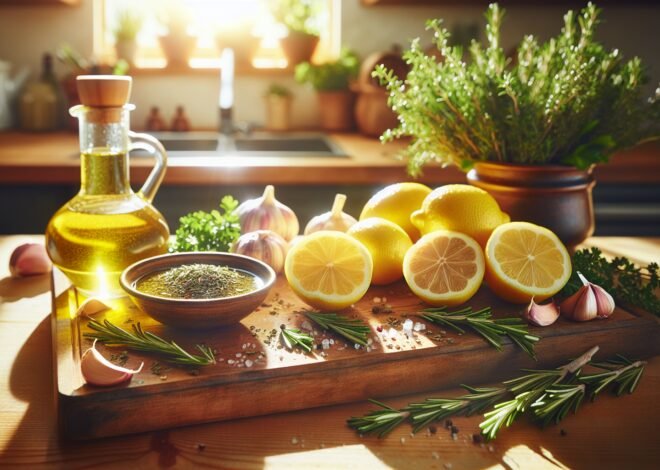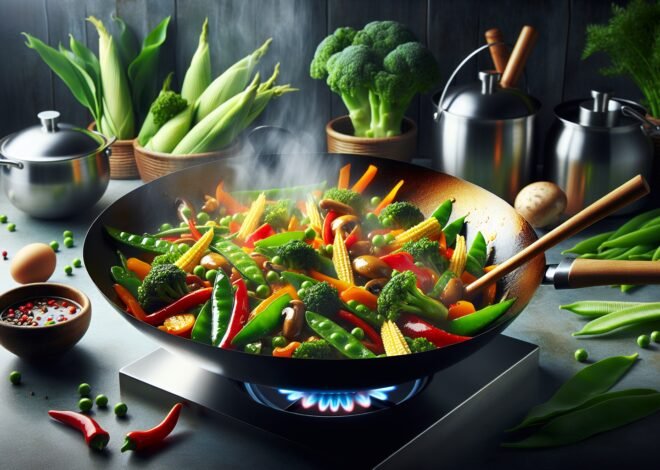
How to Use Basil, Rosemary, and Thyme in Everyday Cooking
Basil, rosemary, and thyme are staples in everyday cooking, offering both flavor and health benefits. These herbs not only enhance the taste of your dishes but also bring a touch of Mediterranean culinary magic to your kitchen. From fragrant basil uplifting a simple tomato sauce to the earthy undertone of rosemary in roasted meats and the subtle aroma of thyme bringing balance to soups, their versatility is unmatched. This guide will explore practical ways to incorporate these herbs into daily meals, enhancing both flavor and health. Dive in to discover how these herbs can transform your cooking routine with minimal effort.
Benefits of Cooking with Basil, Rosemary, and Thyme
Cooking with basil, rosemary, and thyme transforms ordinary meals into extraordinary experiences. These herbs not only infuse dishes with unique flavors but also offer numerous health benefits. Let’s explore the nutritional advantages, flavor enhancements, and overall health benefits of incorporating these herbs into your meals.
Nutritional Advantages of Basil, Rosemary, and Thyme
Basil, rosemary, and thyme are packed with essential nutrients. Their inclusion in your diet supports overall well-being and boosts certain nutritional profiles.
- Basil: Rich in vitamins A, K, and C, basil acts as a powerful antioxidant. It contains essential minerals like calcium, iron, and magnesium. These nutrients help strengthen bones, boost the immune system, and support heart health.
- Rosemary: Known for its high iron content, rosemary also contains calcium and vitamin B6. It aids digestion and improves cognitive function. The presence of antioxidants like rosmarinic acid enhances your body’s defense against diseases.
- Thyme: This herb is a great source of vitamin C and vitamin A, which are crucial for immune function. Thyme also provides manganese, which is important for bone development and metabolism.
Incorporating these herbs into your meals ensures a delicious way to meet your nutritional needs.
Flavor Enhancements from Fresh Herbs
Fresh herbs elevate the flavor profile of any dish. They add complexity and depth to the simplest recipes, making them memorable and delightful.
- Basil: With its sweet and peppery taste, basil enhances the flavor of Italian dishes like pasta and pizza. It pairs well with tomatoes, bringing a fresh and bright note to salads and sauces.
- Rosemary: This herb has a woody, pine-like aroma, perfect for roasted meats and vegetables. It adds warmth and depth, enhancing the savory notes in your dishes.
- Thyme: Thyme offers a subtle earthiness that complements soups, stews, and roasted vegetables. It blends seamlessly with other herbs and spices, creating a balanced and robust flavor.
Using fresh herbs allows you to experiment with flavors, turning every meal into a creative culinary experience.
Health Benefits of Using Basil, Rosemary, and Thyme in Meals
Including basil, rosemary, and thyme in your diet offers various health benefits, from improved digestion to enhanced brain function.
- Anti-inflammatory Properties: The compounds found in these herbs possess anti-inflammatory properties. They help reduce swelling and pain, offering relief for chronic conditions like arthritis.
- Antioxidant Powerhouses: These herbs are rich in antioxidants that fight free radicals, lowering the risk of chronic diseases. They support heart health by reducing cholesterol levels and improving blood circulation.
- Cognitive Enhancement: Rosemary, in particular, is known for its ability to boost memory and concentration. Its aroma alone can improve cognitive performance and mood.
- Digestive Aid: Thyme and rosemary aid digestion by relaxing the muscles of the gastrointestinal tract. They help alleviate symptoms of indigestion and bloating.
Incorporating these herbs into your meals not only enhances flavor but also contributes to a healthier lifestyle.
Creative Ways to Incorporate Basil, Rosemary, and Thyme in Dishes
Exploring creative ways to use basil, rosemary, and thyme in your cooking can open up a world of flavors. These herbs aren’t just for garnish; they can be the star of the show. Let’s dive into unique recipes, culinary techniques, and ingredient pairings that highlight these versatile herbs.
Unique Recipes that Highlight Basil, Rosemary, and Thyme
Creating dishes that celebrate these herbs brings out their full potential. Here are some unique recipes to inspire your culinary journey.
- Basil Pesto Pasta: Blend fresh basil leaves with garlic, pine nuts, Parmesan cheese, and olive oil for a vibrant pesto sauce. Toss it with your favorite pasta for a simple yet flavorful meal.
- Rosemary Lemon Chicken: Marinate chicken breasts in a mixture of rosemary, lemon juice, olive oil, garlic, and salt. Grill or bake until golden and juicy, serving with roasted potatoes and vegetables.
- Thyme and Mushroom Risotto: Sauté onions and garlic in olive oil, add Arborio rice, and cook with vegetable broth. Stir in fresh thyme and sautéed mushrooms for a creamy, aromatic risotto.
These recipes showcase the unique flavors of basil, rosemary, and thyme, making them the centerpiece of your meal.
Culinary Techniques for Incorporating Basil, Rosemary, and Thyme
Mastering the art of using herbs involves understanding how to incorporate them effectively in your cooking.
- Infusing Oils and Vinegars: Create herb-infused oils and vinegars by steeping fresh basil, rosemary, or thyme in warmed olive oil or vinegar. Use these infusions to dress salads or marinate meats.
- Herb Butters: Mix softened butter with chopped herbs and a pinch of salt. Use it to top grilled meats, spread on bread, or melt over vegetables.
- Herb-Crusted Meats: Coat meats like lamb or pork with a mixture of chopped rosemary and thyme, breadcrumbs, and Parmesan cheese before roasting or grilling.
These techniques enhance the aroma and taste of your dishes, offering a gourmet touch to everyday meals.
Pairing Basil, Rosemary, and Thyme with Other Ingredients
Understanding how to pair herbs with other ingredients can elevate your cooking to new heights.
- Basil: Pairs well with tomatoes, mozzarella, strawberries, and lemon. It complements the sweetness of fruits and the creaminess of cheeses.
- Rosemary: Works beautifully with lamb, potatoes, garlic, and citrus fruits. Its robust flavor stands up well to hearty dishes.
- Thyme: Matches perfectly with mushrooms, beef, onions, and wine. Its earthy notes enhance the savory elements in your dishes.
Experimenting with these pairings can lead to exciting flavor combinations, making every meal a delightful experience.
Growing and Storing Basil, Rosemary, and Thyme for Cooking
Growing your own herbs ensures a fresh supply of basil, rosemary, and thyme for your kitchen. It’s not only rewarding but also cost-effective. Let’s explore the best practices for cultivation, harvesting, preserving, and storing these herbs.
Best Practices for Cultivating Basil, Rosemary, and Thyme
Successfully growing herbs requires understanding their individual needs. Here are some tips to help you cultivate basil, rosemary, and thyme.
- Basil: Prefers warm, sunny environments with well-drained soil. It’s an annual herb, so it requires regular watering and pruning to encourage bushy growth.
- Rosemary: Thrives in full sun and well-drained soil. It’s a perennial, meaning it can grow for several years. Rosemary is drought-tolerant, so avoid over-watering.
- Thyme: Requires a sunny spot with light, sandy soil. Like rosemary, thyme is a perennial. It benefits from regular pruning to maintain its shape and encourage new growth.
Providing the right conditions ensures healthy plants that will supply you with fresh herbs throughout the season.
How to Harvest and Preserve the Freshness of Basil, Rosemary, and Thyme
Knowing when and how to harvest your herbs is crucial for maintaining their flavor and nutritional value.
- Harvesting Basil: Pick leaves in the morning after the dew has dried. Use scissors to snip stems just above a leaf node to encourage new growth.
- Harvesting Rosemary: Trim stems regularly, taking only the top two-thirds. This encourages a fuller plant and prevents woodiness.
- Harvesting Thyme: Snip stems as needed, avoiding cutting too close to the base. This ensures a steady supply of leaves without damaging the plant.
To preserve freshness, store herbs in a glass of water on the countertop or refrigerate them wrapped in a damp paper towel.
Storing Basil, Rosemary, and Thyme for Maximum Shelf Life
Proper storage techniques can extend the shelf life of your herbs, ensuring they’re ready when you need them.
- Basil: Store fresh basil in a glass of water at room temperature, away from direct sunlight. For long-term storage, freeze whole leaves or blend them with olive oil and freeze in ice cube trays.
- Rosemary: Keep rosemary sprigs in a perforated plastic bag in the refrigerator. It can also be dried or frozen for extended storage.
- Thyme: Store thyme in the refrigerator in a plastic bag or freeze it in airtight containers.
Using these methods, you can enjoy the fresh flavors of basil, rosemary, and thyme long after the growing season has ended.
Conclusion
The article discusses the culinary and medicinal uses of basil, rosemary, and thyme. Basil is highlighted for its sweet and aromatic qualities, commonly used in Italian dishes like pesto and Caprese salad. Rosemary is noted for its strong, pine-like aroma, often used in seasoning meats and roasted vegetables. Thyme is praised for its subtle earthiness, frequently included in soups, stews, and as a part of bouquet garni. Additionally, these herbs possess health benefits, such as anti-inflammatory and antioxidant properties.
FAQ
What are the health benefits of using basil, rosemary, and thyme in cooking?
Basil, rosemary, and thyme offer a variety of health benefits. Basil is known for its anti-inflammatory properties and can aid digestion. Rosemary contains antioxidants that help improve memory and concentration. Thyme has antibacterial properties and supports respiratory health. Including these herbs in meals can enhance flavors while boosting overall health.
How can I incorporate basil, rosemary, and thyme into everyday recipes?
Incorporating these herbs into daily cooking is simple. Add fresh basil to salads, pizzas, or pasta dishes for a burst of flavor. Use rosemary to season roasted meats and vegetables. Thyme pairs well with soups, stews, and marinades. Experiment with different combinations to discover flavor profiles that suit your taste preferences.
Are there any substitutes for basil, rosemary, and thyme if I run out?
When basil is unavailable, try replacing it with spinach or mint for a similar fresh taste. Sage can substitute rosemary, offering a slightly different flavor but still complementing similar dishes. Oregano or marjoram can stand in for thyme. Experimenting with other herbs can lead to unique and delightful flavors.
What is the best way to store fresh basil, rosemary, and thyme to prolong their shelf life?
Store fresh basil by placing the stems in a glass of water, covering it loosely with a plastic bag, and keeping it on the counter. Refrigerate rosemary and thyme by wrapping them in a damp paper towel and placing them in a sealed plastic bag. Proper storage maintains freshness and extends shelf life.
Can basil, rosemary, and thyme be used together in herbal teas?
Combining basil, rosemary, and thyme in herbal teas creates a flavorful and aromatic blend. These herbs can be steeped together to produce a refreshing and soothing beverage, offering both a delightful taste and potential health benefits such as improved digestion and relaxation.
How do you properly dry and preserve basil, rosemary, and thyme at home?
Drying these herbs is straightforward. Hang small bundles upside down in a warm, dry area until they become brittle. Alternatively, use a dehydrator for faster drying. Once dried, store them in airtight containers away from sunlight. Preserving herbs in this way ensures they retain their flavor and aroma for future use.











